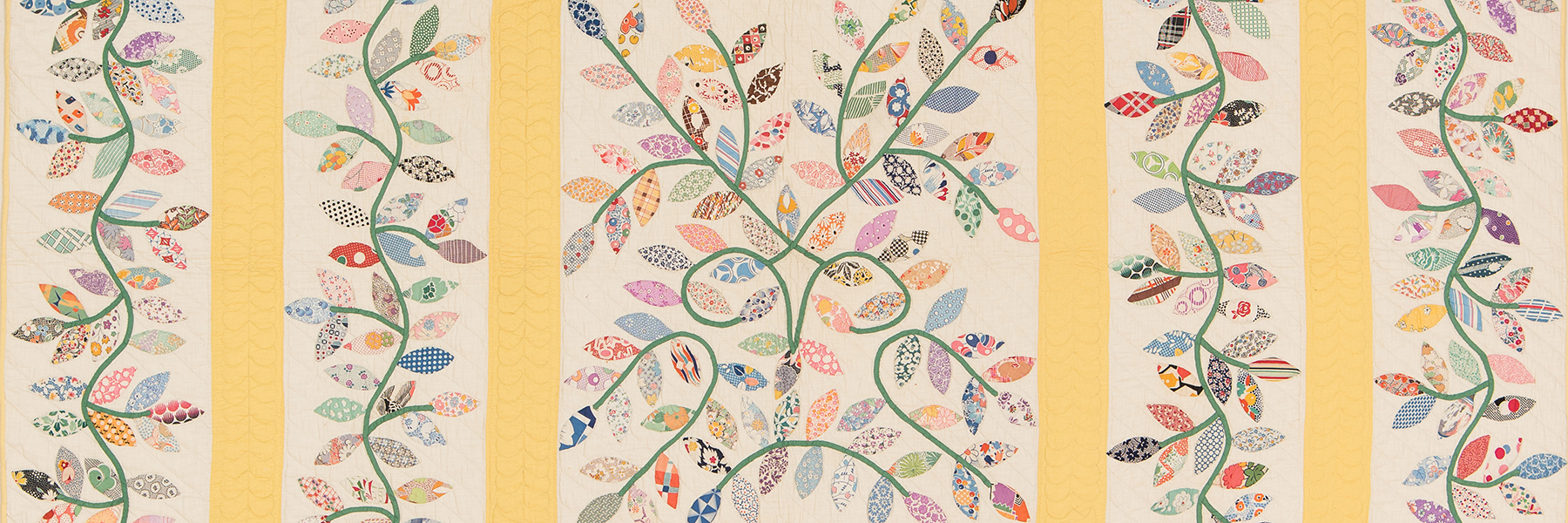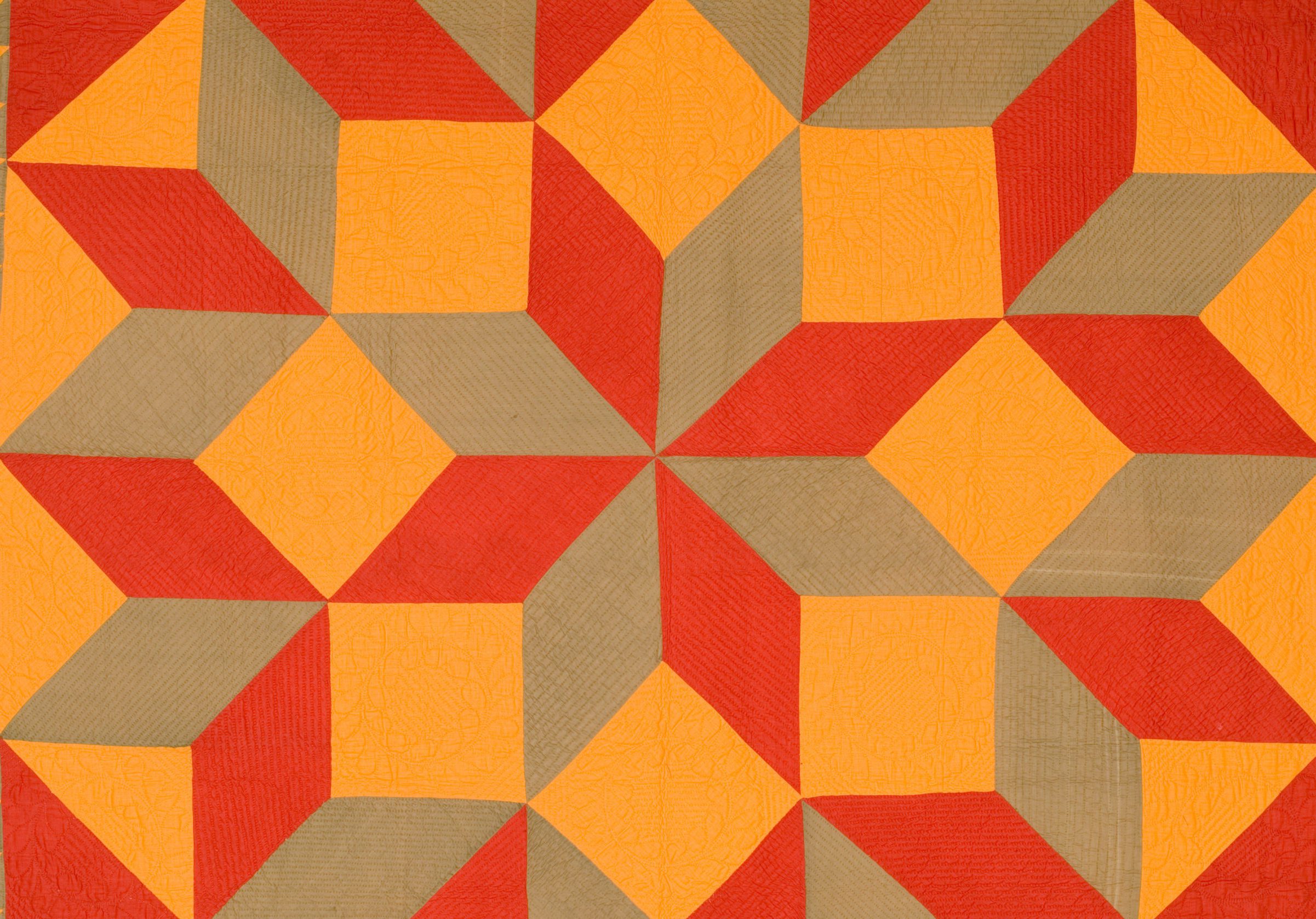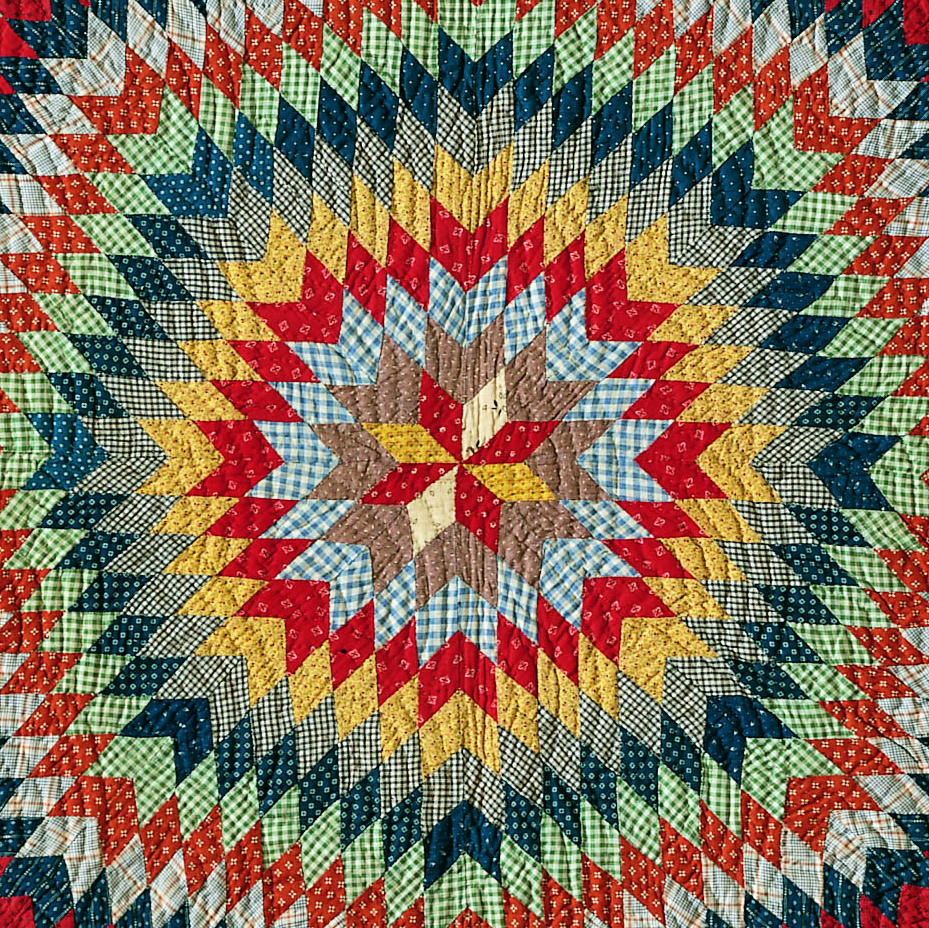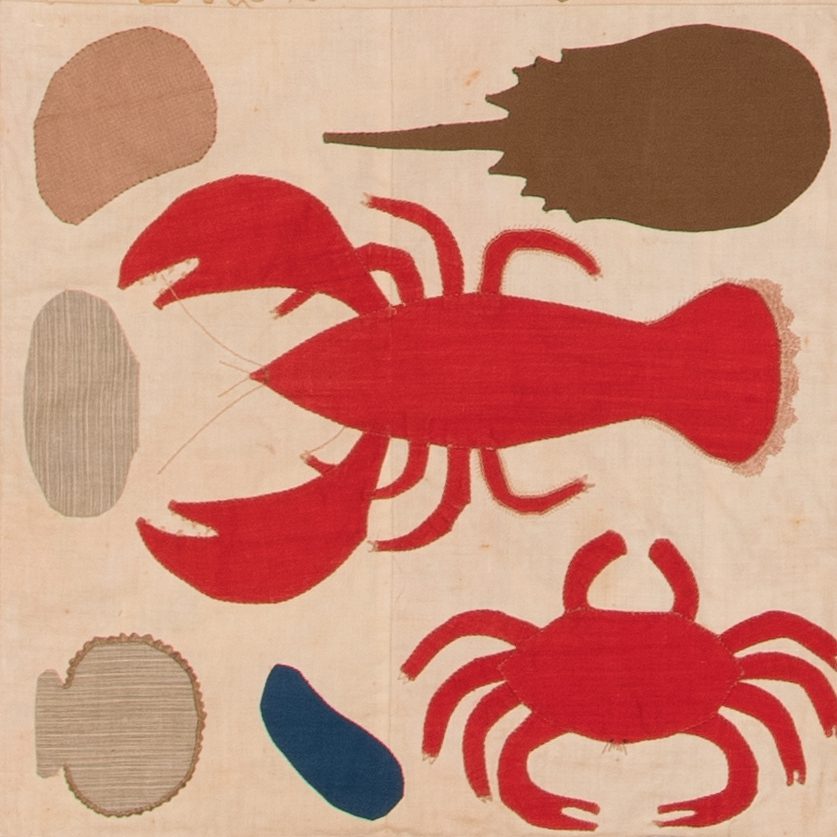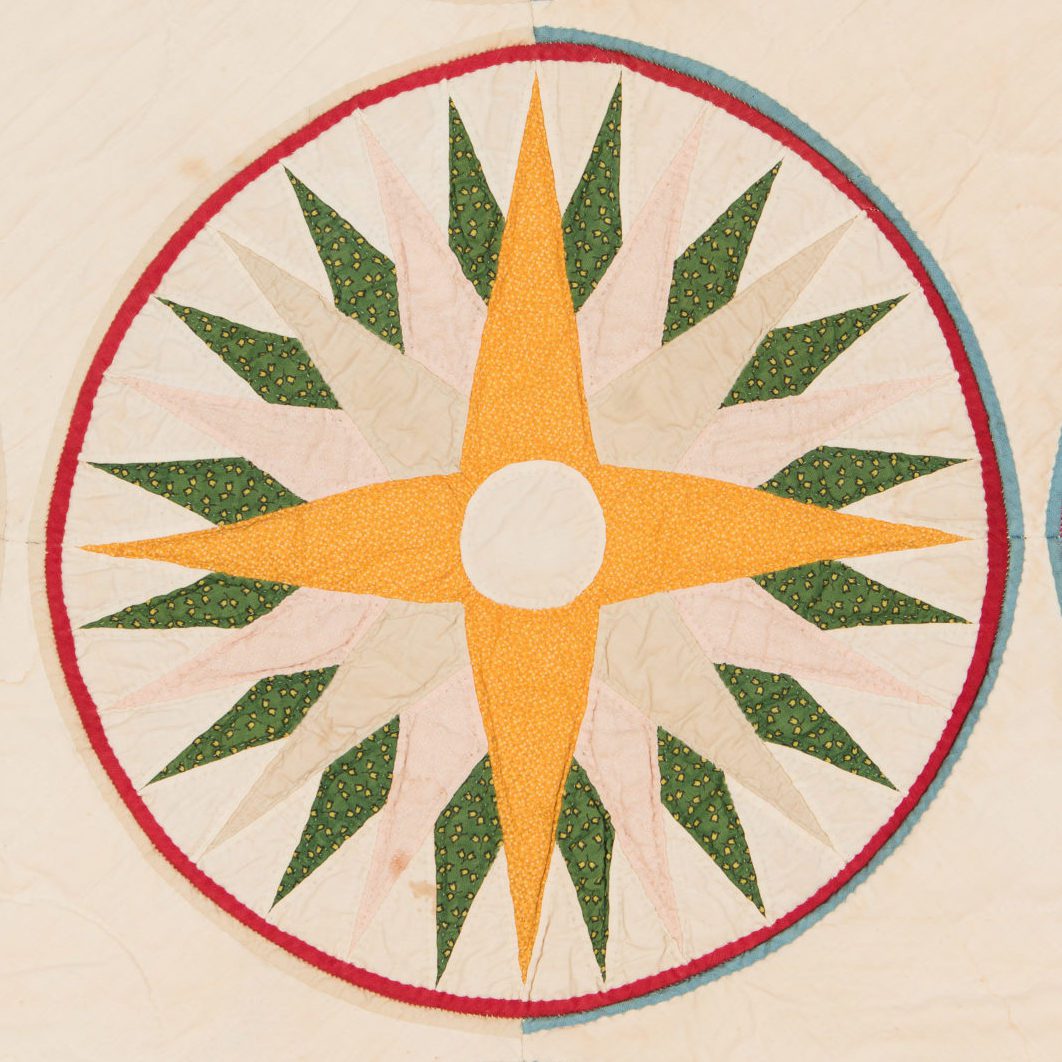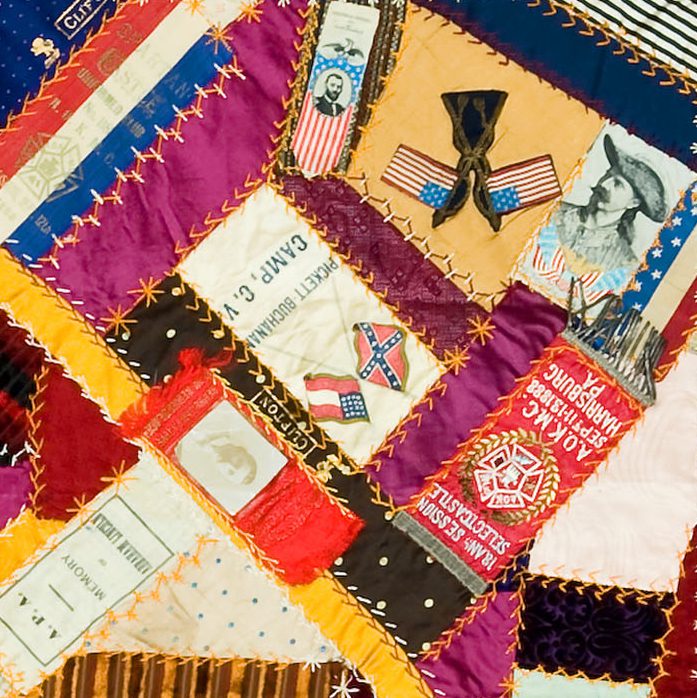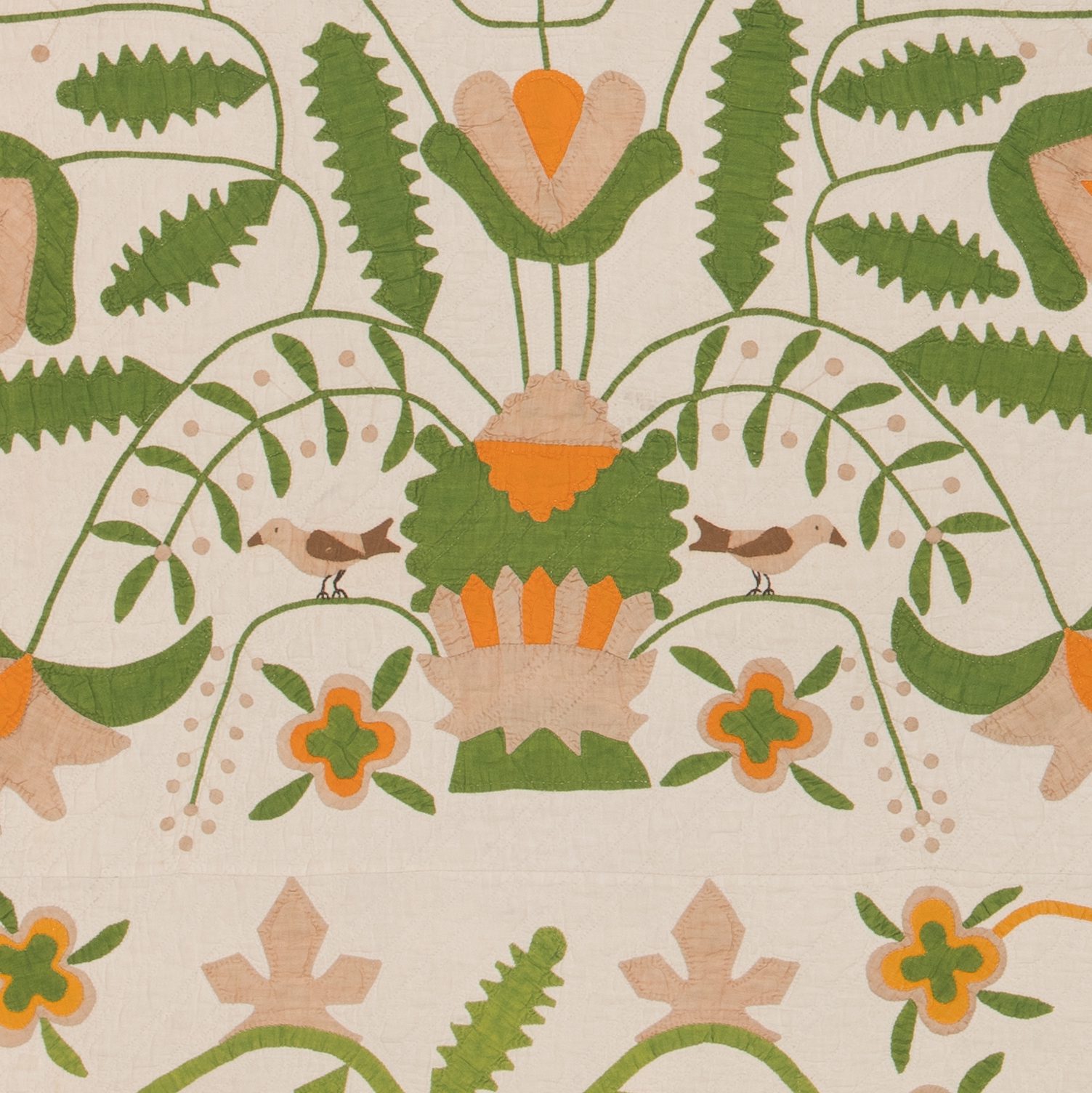

Fascinated by design elements of color, pattern, line, and construction, and eager to recover a quintessentially “American” form of material culture, Shelburne Museum founder Electra Havemeyer Webb (1888–1960) was one of the first to exhibit quilts as works of art in a museum setting. Mrs. Webb established the nucleus of Shelburne’s collection with over 400 historic bedcoverings in the 1950s. Today, Shelburne is known internationally for the exceptional variety and quality of its collection, which is particularly strong in its holdings from 19th-century Vermont and New England.
Throughout the history of quilt-making, the finest pieces were often made to be admired rather than used. Brought out on special occasions, highly prized bedcovers linked family and community histories, bridging the gap between domestic life and public display. Young women often created quilts as part of their dowries, and quilts were gifted as expressions of friendship, devotion, or charity. By the middle of the 19th century, adept quilt-makers competed for prizes and local renown at state and county fairs. Today, quilt-making is recognized as an art form in its own right, revealing makers’ skills and personal visions from complex geometric designs that would feel at home in a gallery of Pop Art to delicate patterns drawn from nature. Bringing together twenty masterpieces dating from the first decades of the 1800s to the turn of the 21st century, Pattern & Purpose explores objects that expand our sense of what art can be, and recognize how invention and discovery can be found in the most familiar of places.
Generous support for this exhibition is provided by The Donna and Marvin Schwartz Foundation.

A. Elmer Crowell (East Harwich, Massachusetts, 1862-1952)
Miniature Canada Goose Bird Carving, 1894
Wood and paint, 2 3/8 x 1 11/16 x 3 7/8 in.
Gift of Mrs. Stuart Crocker, in memory of her husband, 1966-232.11
Inscribed on its base with the date 1894, this miniature Canada goose is the earliest documented example of A. Elmer Crowell’s small decorative carvings. Some experts debate the influence fellow Massachusetts decoy carver Joseph Whiting Lincoln’s (1859-1938) miniature bird carvings might have had on Crowell and his early attempts. This goose differs from later works in its more detailed head carving, including an incised mandible. Its less refined, unblended plumage is more reminiscent of the abstracted patterns found on Lincoln’s miniatures.


Unidentified maker (Pennsylvania)
Pieced Mennonite Broken Star Medallion Quilt, 1890–1910
Cotton, 78 1/2 x 78 1/2 in.
Gift of Mr. and Mrs. Michael Polemis, 2006-13.10
Using simple combinations of diamonds and squares, the maker of this Broken Star Medallion Quilt has created an optical illusion of cubes, hexagons, and stars. Achieving the look of the stacked cubes requires three fabrics in varying intensities of color—one dark, one medium, and one light.
Collectors and historians have lauded eye-catching Amish and Mennonite quilts since the 1970s for their geometric design sense, liberal use of jewel-like fabrics, and carefully quilted feathers, scrolls, and other motifs—but what makes a bedcover “Amish” or “Mennonite,” anyway? “Amish” or “Mennonite” quilts are simply bedcovers made or used by Amish or Mennonite families. While there are no exacting rules for quilts made in these communities, common characteristics like pattern types or needlework themes have emerged in part because codes of conduct tend to value conformity over individualism.

Unidentified maker (Baltimore, Maryland)
Major Ringgold Album Quilt, 1847–50
Cotton and ink, 94 x 111 1/2 in.
Museum purchase, 1959-270
Major Samuel Ringgold (1796–1846) was an officer in the United States Army who became known for several major military innovations, earning the moniker “The Father of Modern Artillery.” Traveling across the nation to demonstrate his inventive “Flying Artillery”—the practice of mounting lighter guns on carriages so they could be pulled by teams of horses—Ringgold was best known for his displays at Baltimore’s Fort McHenry and as the first officer to die during the Mexican-American War in 1846.
Given the Major’s popularity in Baltimore, it is not surprising that the center top block of this album quilt includes a depiction of a monument to the departed officer. Baltimore-style quilts like this one, made by professional seamstresses and skilled amateurs alike, are known for the excellence of their craftsmanship, their use of elegant fabrics, and the overall harmony of their design. In the mid-19th century, Baltimore was the second largest port in America, providing a wide variety of printed textiles for the production of eye-catching bedcovers like this one.
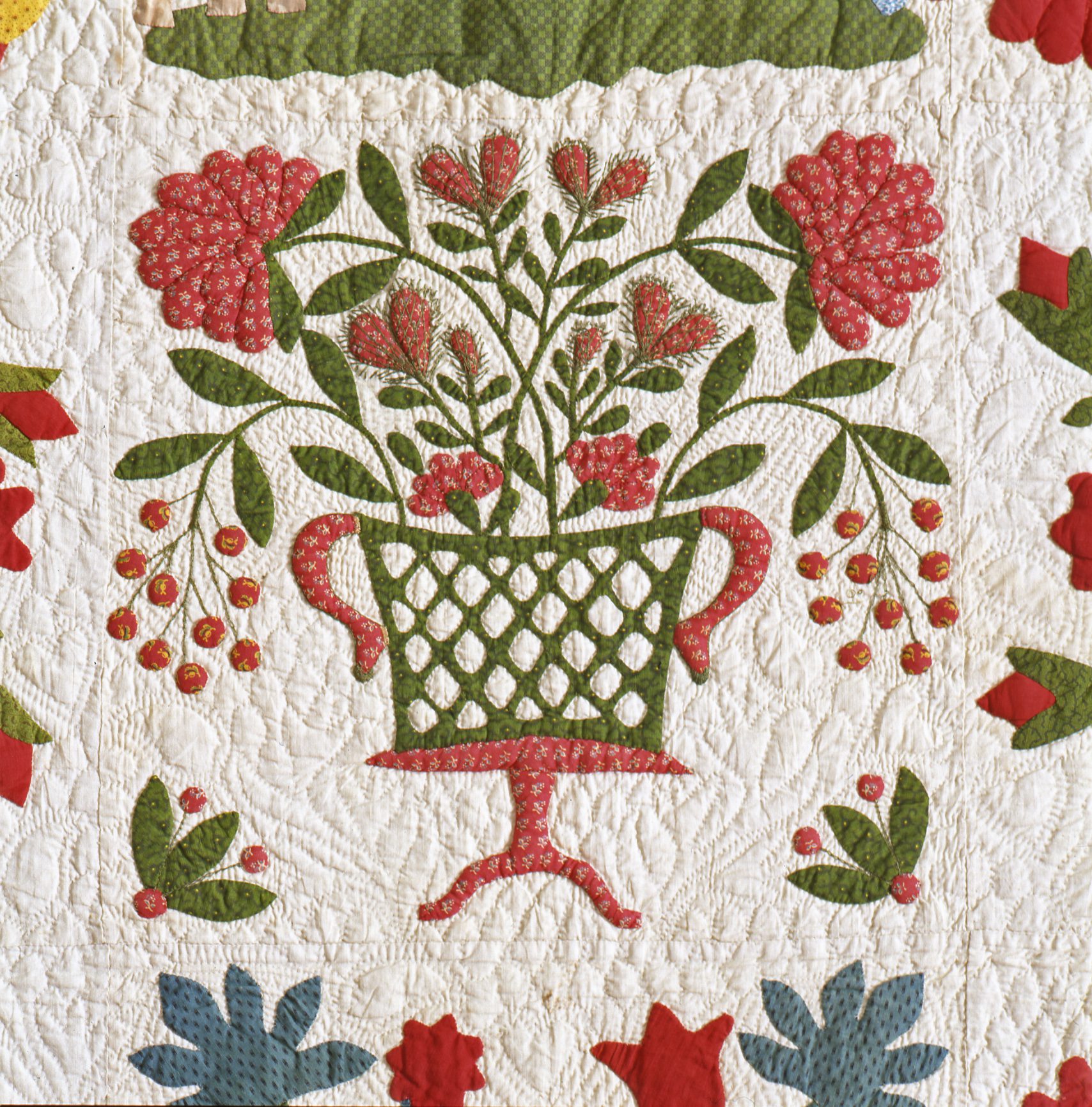




Unidentified maker (Maine)
Pieced Explosion Quilt, ca. 1885
Cotton, 77 1/2 x 76 in.
Gift of Elizabeth M. Billings and Harriet Miller, 2001-36
This unusual quilt is something of a puzzle. Close examination reveals that this bedcover’s 34 circular medallions have been individually constructed and bound with red and blue cottons, and then set into the ground fabric. Historian Pamela Weeks has named these intriguing bedcovers “potholder quilts,” arguing that this quilt-as-you-go method might have appealed to makers who wanted a portable project, or even home needle workers who did not have access to or the means to purchase larger cuts of cloth traditionally used for backing fabric.

Unidentified maker
Pieced Mennonite Pineapple Quilt, ca. 1880
Cotton, 77 x 67 1/2 in.
Gift of Jean Lovell, 2017-18.2
Jean Lovell, a longtime friend of Shelburne Museum, has been collecting historic quilts since 1979. Inspired both by family tradition and the renewed interest in American quilts spurred by landmark museum exhibitions in the 1970s, 80s, and 90s, Jean noted: "I've always loved quilts from my high school days. I had a grandmother who quilted well into her 90's. She made lovely quilts which my family used on our beds. Her designs were well thought out and special—especially the way she dealt with colors… In the early 1980s I happened to meet the owners of the American Hurrah gallery in New York City. They had a lot of Amish quilts which spoke to me like no other kind of quilt has before or since. Even though I have collected others they became my main love—the colors, design, execution, and depth are just extraordinary… This bedcover was one of my early purchases of 'fine' quilts in about 1986."

Unidentified maker
Pieced Centennial Flag Print Quilt, 1876
Cotton, 90 5/8 x 97 7/8 in.
Gift of J. Watson Webb, Jr., 1952-571
While this quilt’s impressive top features pieced stars and patriotic red, white, and blue cottons, the bedcover’s back was assembled using nine commemorative handkerchiefs from the 1876 Centennial Exhibition in Philadelphia. These affordable, portable souvenirs featured prominent landmarks from the fair’s grounds in Fairmount Park like Memorial Hall, American and international flags, and even the full text of the Declaration of Independence. The two lower corners of the quilt, originally cut out to accommodate the corner posts of a bed, were likely added when bedding styles or the needs of the user changed.
For two additional bedcovers in Shelburne’s collection inspired by the Centennial Exposition, see the Burdick-Childs Quilt (1987-40) and the Appliqué, Embroidered, Painted, and Pieced Patriotic Crazy Quilt (2009-13).

Mrs. Powers (Presque Isle, Maine, dates unknown)
Appliqué and Pieced Laurel Leaves Quilt, 1840–60
Cotton, 91 1/8 x 74 1/4 in.
Gift of Miss. Edith H. Porter, 1954-423
With its precisely appliquéd and pieced blue leaves, this quilt may have been created with another kind of bedcover in mind: the fancy blue-and-white coverlets that were woven on jacquard looms and popular during the 19th century. Bedcovers like these might also have coordinated with other blue-and-white decorations in the American 19th-century home, like Dutch earthenware or Chinese export porcelains. The colorant used for the blue fabrics in this quilt was probably derived from the leaves of plants in the genus Indigofera, better known as indigo, the same stable dyestuff that is used to tint denim for blue jeans. Indigo, sometimes called “blue gold” because of its value as a trading commodity, was an important cash crop in the American south in the early 19th century. The unusually colorfast dyestuff’s appeal remained strong through the 1800s because it could be processed into cakes for easy transport.

Unidentified maker
Appliqué, Embroidered, Painted, and Pieced Patriotic Crazy Quilt, ca. 1893
Cotton, silk, beads, and sequins, 72 x 72 in.
Museum purchase, 2009-13.
Embellished with a rich selection of materials including beads, sequins, and 104 commemorative ribbons, this crazy quilt is a remarkable record of popular culture of American life after the Civil War. Noting political figures like presidents Abraham Lincoln, James Garfield, and Ulysses S. Grant; recalling military history with references to the Grand Army of the Republic and Confederate Veterans; and even highlighting popular events and personalities like Philadelphia’s Centennial Exposition and “Buffalo Bill” Cody, the carefully assembled montage of souvenirs and rich fabrics performs almost like a scrapbook or shadow box, and would likely have been displayed in a parlor or other public space in the home. Found in Harrisburg, Pennsylvania without a known maker or provenance, ribbons featuring locations like Pittsburgh, Philadelphia, and Germantown seem to indicate that the object may have been made in central Pennsylvania during the final years of the 19th century.
For two additional bedcovers in Shelburne’s collection inspired by the Centennial Exposition, see the Burdick-Childs Quilt (1987-40) and the Pieced Centennial Flag Print Quilt (1952-571).

Unidentified maker (Ohio)
Appliqué and Pieced Four Little Birds Quilt, 1860–80
Cotton, 85 3/4 x 82 1/8 in.
Museum purchase, acquired from Florence Peto, 1955-644
In 1939 renowned quilter, collector, and historian Florence Peto (1881–1970) remarked, “my photographs of American-made quilts, spreads, and woven coverlets number over three hundred—all have authentic histories verified by family records and papers. What I desire to do in gathering this material [is to] preserve the memory and identity of the quiltmaker as well as her needlework.” Peto’s approach to research and documentation appealed to Shelburne Museum founder Electra Havemeyer Webb, and for more than a decade Peto advised Mrs. Webb on acquisitions for the museum’s textile collection. Thought to have been made in Ohio between 1860 and 1880 because of a handful of other dated quilts with similar baskets, Mrs. Webb purchased this remarkable appliquéd bedcover from Peto in 1955.

Unidentified Odawa maker (Peshawbestown, Michigan)
Appliqué and Pieced Star of Bethlehem Quilt, 1900–25
Cotton, 78 x 70 in.
Gift of John Wilmerding, 1988-16
This quilt, the only bedcover in Shelburne’s collection made by a Native American, combines a central, pieced star pattern with blocks of appliquéd flowers forming the border. Quilting was not an indigenous needlework tradition, but rather was introduced to Native communities via the establishment of Catholic missions and the influx of Euro-American settlers in the Great Lakes region during the 19th century.
While we do not know the identity of the maker of this bedcover, research by historian Marsha MacDowell has illuminated a group of Odawa women who quilted together during the first quarter of the 20th century in the basement of the St. Kateri Tekakwitha Church, a Catholic Church on reservation land held by the Grand Traverse Tribe of Ottawa and Chippewa Indians. Several bedcovers created by these women are in the collection of the Michigan State University Museum and share the bright printed cotton fabrics, kaleidoscopic, radiating stars, and distinctive four- and five-petal floral motifs that distinguish Shelburne’s quilt. These decorative elements are typical components of Odawa craft, and mimic motifs found in earlier porcupine quillwork and beaded decoration from indigenous communities in the Great Lakes region.
Explore the Quilt Index to see a group of related Odawa quilts in the collection of the Michigan State University Museum via the links below:
Maker unknown (Peshawbestown, Leelanau County, Michigan)
Lone Star / Star of Bethlehem, ca. 1920
Collection of Michigan State University Museum acc.#2011:161.
Anna David (Peshawbestown, Leelanau County, Michigan)
Lone Star with floral applique / Star of Bethlehem, ca. 1920
Collection of Michigan State University Museum acc.#6615.
Margaret Ogahmahgegedo (Odawa, Agosatown, Leelanau County, Michigan)
Lone Star with floral applique / Star of Bethlehem, 1912
Collection of Michigan State University Museum acc.#6814.1
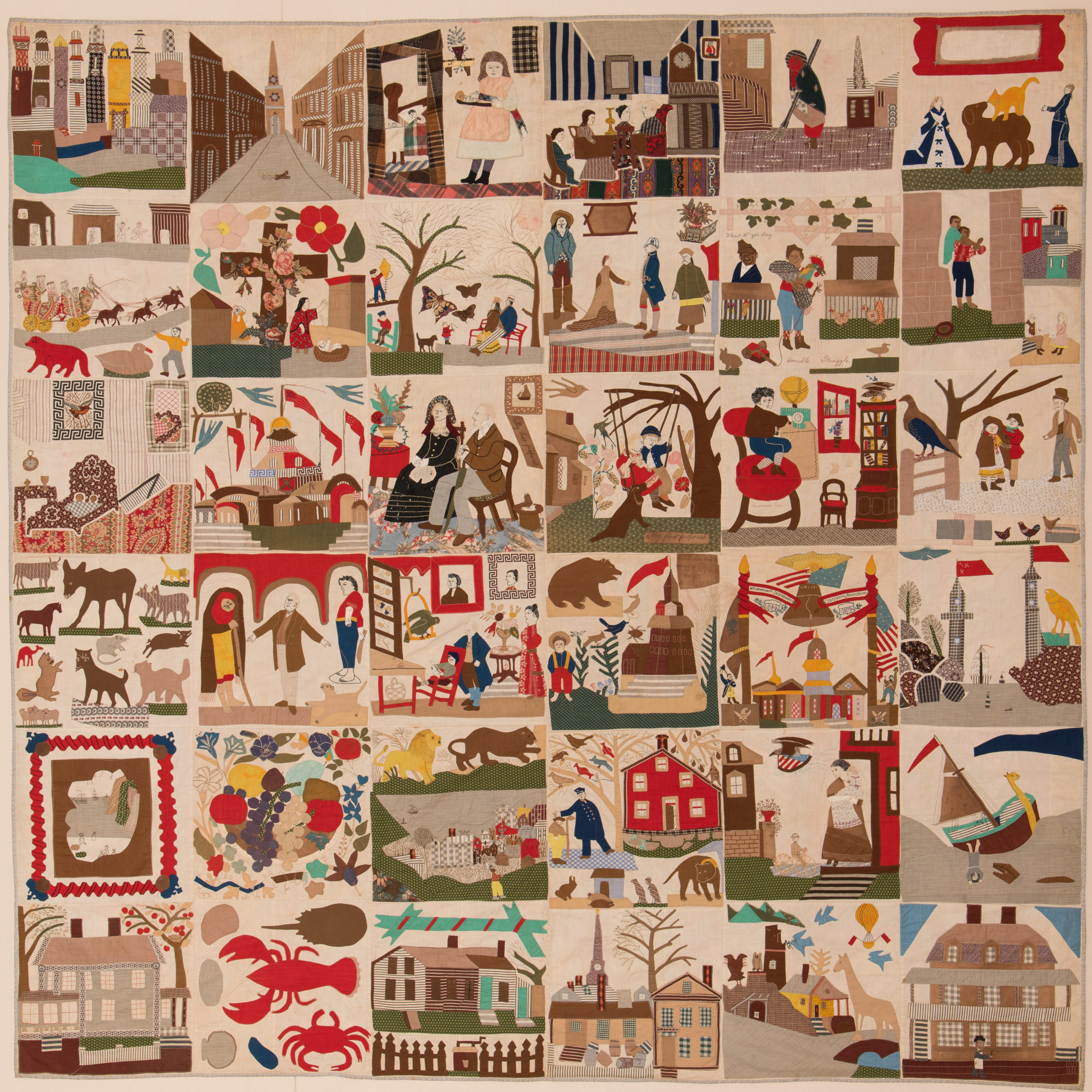
Attributed to Minnie Melissa Burdick (North Adams, Massachusetts, 1857–1951)
Burdick-Childs Quilt, 1876
Cotton and silk, 79 x 79 3/4 in.
Museum purchase, 1987-40
This quilt, the only bedcover in Shelburne’s collection made by a Native American, combines a central, pieced star pattern with blocks of appliquéd flowers forming the border. Quilting was not an indigenous needlework tradition, but rather was introduced to Native communities via the establishment of Catholic missions and the influx of Euro-American settlers in the Great Lakes region during the 19th century.
The 36 blocks in this quilt illustrate scenes of family and domestic life in North Adams, Massachusetts, as well as biblical themes, such as the story of Jonah and the whale. Additionally, the Centennial Exposition of 1876 inspired two of the blocks. Held in Philadelphia, Pennsylvania, this event commemorated the one hundredth anniversary of America’s independence. The spectacle was widely publicized and lavishly described and illustrated in popular journals of the time. These reports might have served as a guide for the buildings featured in this quilt: one of the buildings closely resembles Memorial Hall, the key architectural structure of the Exposition, and another depicts the Women’s Pavilion. At the Exposition, this building was exclusively devoted to displaying artworks and products resulting from women’s labor.
For two additional bedcovers in Shelburne’s collection inspired by the Centennial Exposition, see the Appliqué, Embroidered, Painted, and Pieced Patriotic Crazy Quilt (2009-13) and the Pieced Centennial Flag Print Quilt (1952-571).

Caroline Carpenter Smith Persons (Northfield, Vermont, 1835–1902)
Appliqué and Pieced Sunflower Quilt, 1860–80
Cotton, 77 3/4 x 85 1/2 in.
Gift of Ethel Smith Washburn, 1987-19
The tall sunflowers appliquéd and quilted on this bedcover may have been inspired by the mid-19th-century design vocabulary of the English Arts and Crafts Movement, which was widely known in America through books and magazines." content="This movement advocated for traditional craftsmanship using high-quality materials, and often emphasized flat or streamlined naturalistic motifs. The stylized flowers, leaves, and stems of this eye-catching bedcover were appliquéd onto the white background, which is richly textured with hand-quilted stitches. The maker, Carrie M. Carpenter, inscribed her name on the back of the quilt.
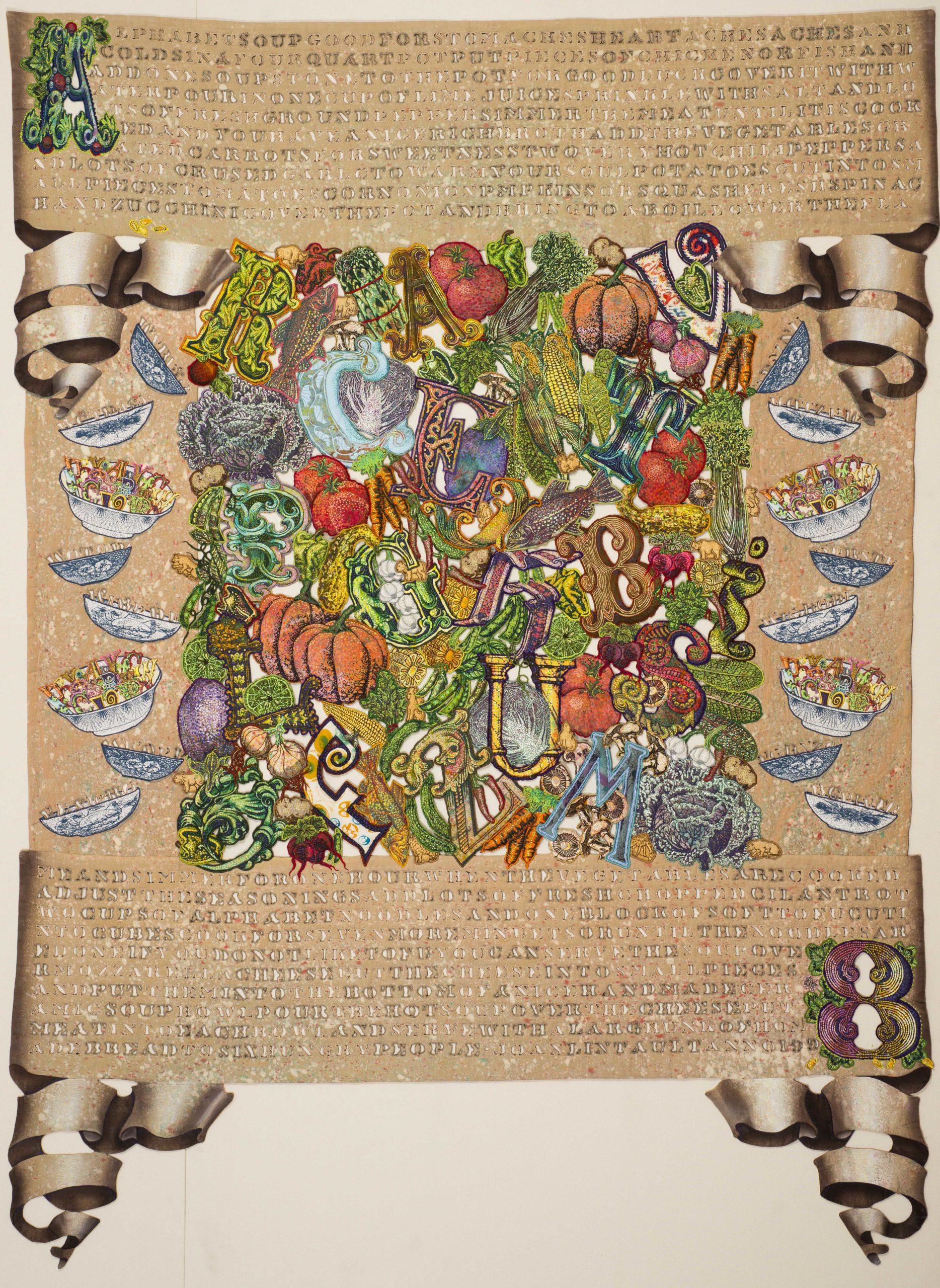
Joan Lintault (New Paltz, New York, b. 1938–2020)
Alphabet Soup, 1998
Cotton, lace, and paint, 99 1/8 x 73 3/8 in.
Museum purchase, 2011-43
Although Joan Lintault collected historic quilts in the 1960s, she never wanted to be a traditional quiltmaker. Instead, because of her background in fine art, she says, “I wanted to use all the elements of art that I was taught, by using thread as line, fabric as shape, and color as paint… I could never understand why there was this deep prejudice against artists who used fabric and fiber. I still don’t understand it.” Accordingly, Alphabet Soup rejects traditional notions of quilts and textile practice: rather than a bedcover, this double-sided art quilt performs as a recipe card complete with helpful hints about ingredient substitutions and portion size.
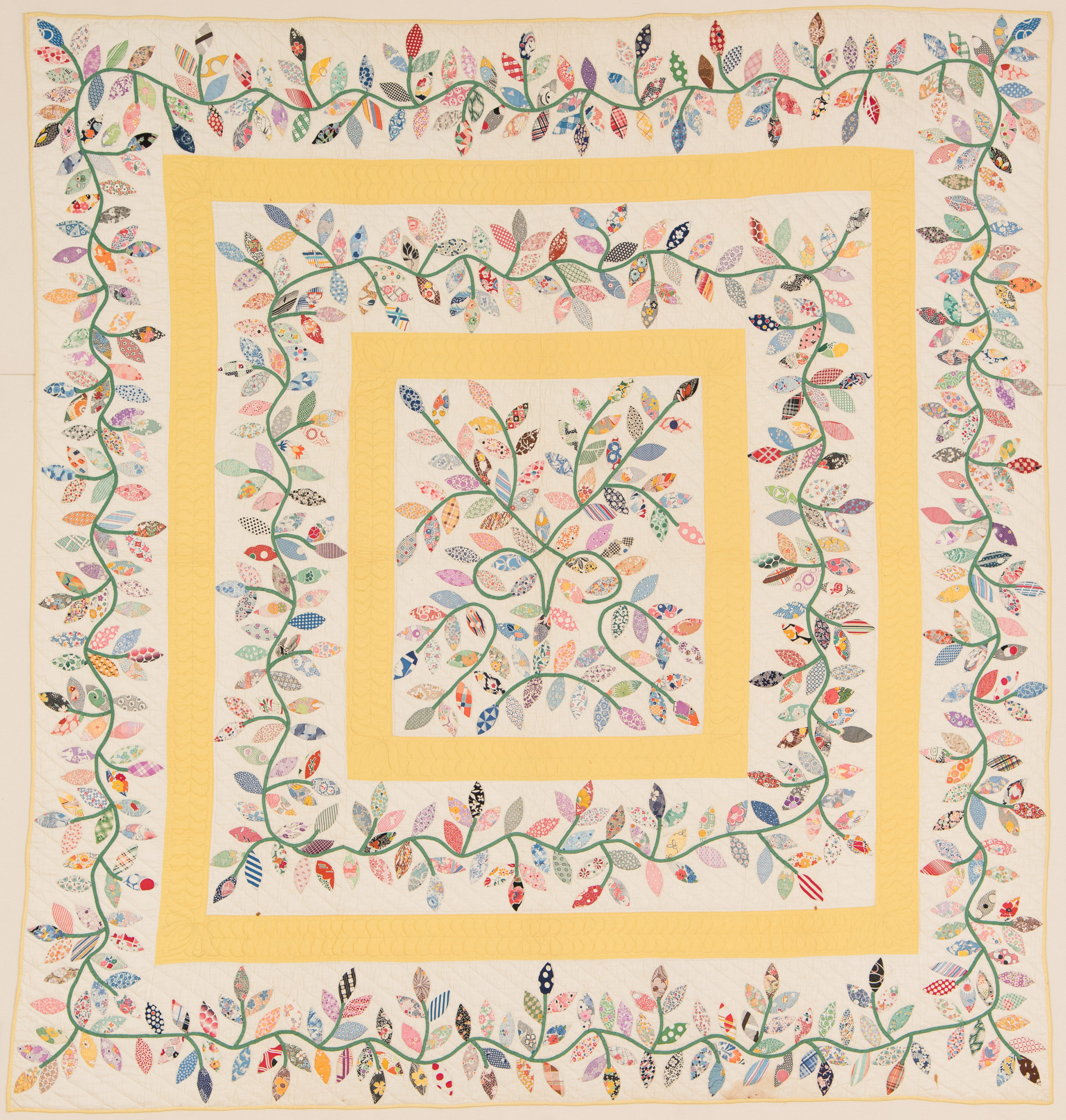
Henrietta Winter Harvey (Columbus, Kansas, 1859–1954)
Appliqué and Pieced Autumn Leaves Medallion Quilt, 1938–40
Cotton, 88 1/2 x 84 in.
Gift of Nancy Willis in Memory of Mary Gail (Harvey) and Harry Lehrer, 2010-10
The bright pastel fabrics used in this Appliqué and Pieced Autumn Leaves Medallion Quilt, sometimes known as “Easter egg colors,” were most popular after 1925. The maker of this quilt, Henrietta Winter Harvey, was born in Pleasantville, Ohio. Around 1883, she moved with her family to western Kansas to homestead. She married and settled in Columbus, Kansas. Around the age of 80, she made this exceptional bedcover as a wedding gift for her granddaughter, who was married in 1940.

Joe Cunningham (San Francisco, California, b. 1952– )
The Rule of Three, 2011
Bamboo, cotton, and polyester, 70 7/8 x 71 5/8 in.
Museum purchase, 2012-10
Stories that use the so-called “Rule of Three” employ repetition as a critical means of developing a narrative that can be easily recalled. This quilt, which uses three different types of cloth for its top, also reflects on how we remember. According to the artist, “This quilt is about memories and how they are burned into our minds. It is one of a series of quilts I have made addressing the irregular border between conscious and unconscious. The quilting design is ginkgo leaves, which strengthen memories. The quilt employs ideas I took from Amish quilts, such as large pieces of fabric and spare design, which I have adapted to suit my own ends.”

Judy Dales (Greensboro, Vermont, b. 1945– )
Figments, 1998
Cotton, poly-cotton, and rayon, 48 3/8 x 64 1/4 in.
Museum Purchase, 2015-16.1
Contemporary Vermont quilter Judy Dales is fascinated by curves, color, and rhythm—but admits that her process can occasionally take on a life of its own. Dales commented, “During the time when I was writing my book, Curves In Motion, I did a lot of drawing and doodling. I was startled when little ethereal figures began emerging from time to time. I would be happily drawing and suddenly realize I had created another one of these little personages, which I think of as Spirit Figures, each with a distinct personality. I became very friendly with these little ones and eventually included them in the margins of my book, and also in this quilt.”
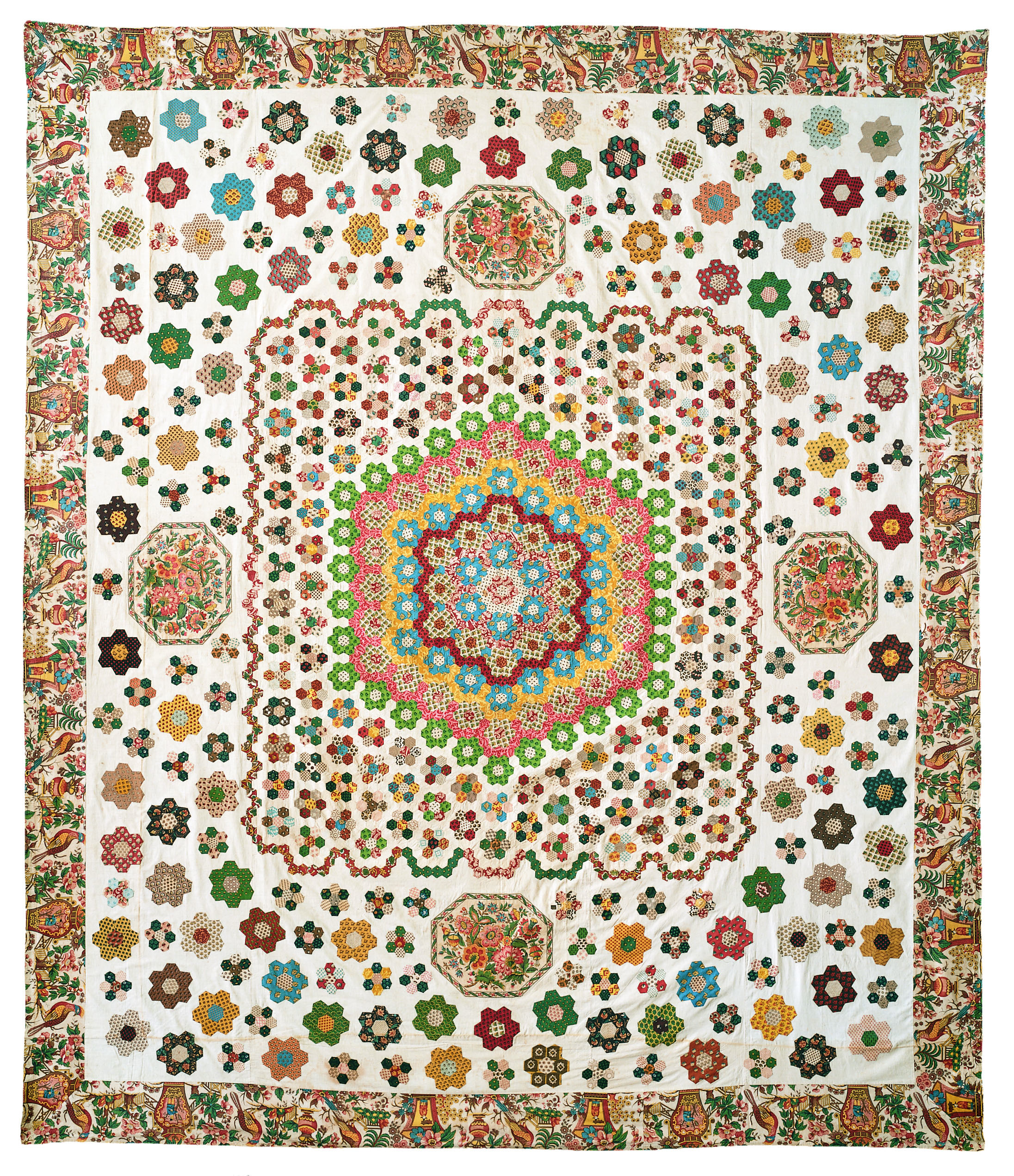
Jane Morton Cook (Scituate, Massachusetts, 1730–d. date unknown)
Broderie Perse and Paper Pieced Charm or Honeycomb Patch Counterpane, 1810–25
Cotton, 99 x 115 in.
Museum purchase, 1957-524
In January 1835 Godey’s Lady’s Book published the first commercially available quilt pattern in America, naming it “hexagon patch-work.” The publication noted, “Perhaps there is no patch-work that is prettier or more ingenious than the hexagon, or six-sided; this is also called honey-comb patch-work. To make it properly you must first cut out a piece of pasteboard of the size you intend to make the patches, and of a hexagon or six-sided form. Then lay this model on your calico, and cut your patches of the same shape, allowing them a little larger all around for turning at the edges.” This classic pattern remained popular with quilters well into the 20th century.

Ella Chase (Derby Line, Vermont, dates unknown)
Pickwick Papers, 1890–1900
Cotton, polyester, and silk, 63 1/2 x 67 1/2 in.
Gift of the Family of Paul A. Taylor, 2010-1.1
Made by Ella Chase when she was teaching sewing in New York City during the final decade of the 19th century, this remarkable medallion-style quilt features a central, embroidered panel with a band of swallows flying over a pond with mushrooms, wildflowers, a butterfly, and a frog. Surrounding the central panel are 16 rectangles depicting characters from Charles Dickens’s popular 1836–37 series, “Posthumous Papers of the Pickwick Club.” The embroidered figures were likely based on period drawings that appeared in Joseph Grego’s Pickwick Pickwickiana, an 1889 compilation of 350 unauthorized illustrations created throughout the 19th century.
Given the orientation of the figures around the central medallion, this quilt was likely meant to be placed on a parlor table and admired from all four sides. Ella’s choice to use vibrant silk taffeta fabrics and her invocation of Dickens’s popular short stories reveal a flair for the fantastic, and perhaps an effort to take a step back from the harsh urban realities of turn-of-the-century New York City.

Ida W. Beck (Easton, Pennsylvania, 1880–1967)
Rainbow Monogram and Initial Quilt, 1950–54
Cotton, 95 3/8 x 88 3/4 in.
Museum purchase, 1955-612
Featuring days of the week, months of the year, and holidays, as well as alphabets, flowers, birds, and butterflies, this quilt is a tour de force of advanced embroidery skills. Executed in the early 1950s, its maker wrote to Shelburne Museum describing her bedcover: “It is hand quilted…quite original and I was several years in planning and making it. [I] am over 70 years old—a shut-in since childhood, so have always done needlework. And monogramming was my specialty for many years. On the center panel is an alphabet monogram, and seven other alphabets in script, block, old English, and others. In all there are about 400 letters, all hand-embroidered in assorted colors, and about 50 flowers, each different.”

Attributed to Emeline G. Perry Proctor (Fair Haven, Vermont, 1849–1936)
Pieced Pyrotechnics Quilt, late 19th Century
Cotton, 91 1/2 x 76 in.
Bequest of Hazel Proctor Ibbotson, 1994-3.1
Emeline Proctor may have been inspired to create this vibrant green, yellow, and purple bedcover via the Ladies Art Company, the first known manufacturer to offer mail-order block patterns. Established in 1889 in St. Louis, Missouri, patterns were priced at 10 cents each, printed on heavy cardboard, and housed in a small paper envelope with a 3-inch color card of the block. By 1895 advertisements suggested that the Ladies Art Company offered as many as 272 quilt block patterns. In 1897 the company published its first printed catalog, offering upwards of 400 designs. This catalog had an enormous influence on the naming of block patterns, and the convenience of mail order quilting supplies for quiltmakers living in rural towns like Fair Haven, Vermont cannot be overstated. An almost identical pattern to the compass-like “pyrotechnics” blocks featured on this bedcover was listed as no. 176 in the 1897 catalog and may have been the inspiration for Emeline’s quilt.

Attributed to Emeline Barker (New York, New York, 1820–1906)
Appliqué and Pieced Mariner's Compass and Hickory Leaf Quilt, ca. 1860
Cotton, 100 x 96 in.
Museum purchase, acquired from Florence Peto, 1952-545
When Shelburne Museum founder Electra Havemeyer Webb acquired this quilt from legendary collector and textile historian Florence Peto neither Webb nor Peto knew the identity of the bedcover’s maker. Rather, they were likely drawn to the variety of bright, printed cotton fabrics and the precise geometry of the quilt’s nine carefully pieced 64-point “Mariner’s Compass” or “Rising Sun” blocks.
Research by Deborah Lyttle Ash has connected this quilt to a remarkably similar bedcover in the collection of the Museum of the City of New York made with similar materials, quilting, and almost identical 64-point compasses marked “Emeline Barker #7” in one corner. Using Census records and the New York City Directory from 1860, Ash revealed that Emeline Barker (1820–1906) lived with her widowed mother Hannah and her sisters Harriet and Amanda in Manhattan’s Lower East Side until 1868, at which point the family relocated to a new brownstone at 127 East 26th Street. Emeline’s great-niece Florence Sullivan described the family in her unpublished memoir: “Hannah and her daughters built the house on 26th St. where they lived for 50 years. All the nieces and nephews loved to visit… The aunts inherited great skill with their needles from their French ancestors. They made beautiful quilts, a wedding veil, and hair wreaths. They were all very small, well rounded and plain. Emeline had a rosy appearance, reddish hair and was the humorous one.”

Unidentified photographer
Mary Cassatt, Grasse, 1914
Gelatin silver print
Frederick A. Sweet research material on Mary Cassatt and James A. McNeill Whistler, 1872-1975. Archives of American Art, Smithsonian Institution.
